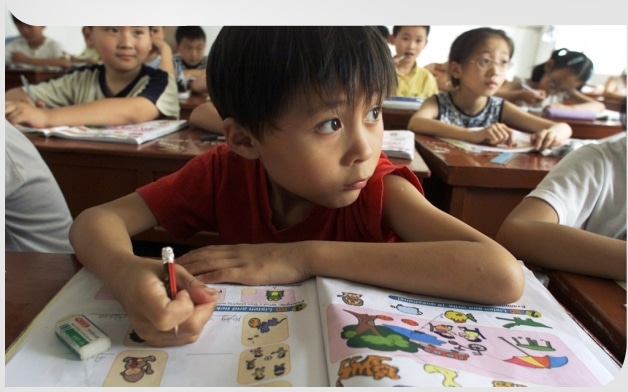Do you remember the very first time you raised your hand in class and asked your teacher a question? Oh yes I do. Vividly.
It was one of the most horrifying and embarrassing days of my life in Hong Kong – I was just five years old in the first grade.
Here’s what happened.
It was one of my favorite classes, art. All of us first graders were sitting up straight, watching and listening attentively to our teacher explain how to draw a beach.
Using a chalk, Mrs. Lee started outlining on the blackboard the picture of a crowded beach on a sunny day. She described meticulously and methodically how we were to start making the sun as a big circle radiating beams of light. Next, small fluffy clouds – seven, to be exact – must surround the sun. Next, another seven tiny sparrows flying above, below, and between these clouds. And finally, she added two tall palm trees on both sides of the beach, and sketched a few big umbrellas on the sand to hint at people sunbathing underneath them.
While Mrs. Lee was painstakingly giving step-by-step instructions, I was beginning to get bored by her drawing and her rigid tone about where everything was supposed to be. She insisted that we pay close attention to detail because we needed to reproduce everything exactly the same way that she had drawn it. I cringed when I heard that – I said to myself, “I don’t want to draw everything the same way you did!”
But then I wondered – do I have a choice? How do I get out of this? What do I say? What do I do?
Just as a million questions were racing through my mind, Mrs. Lee said –
“OK, now it’s your turn to draw. But first, any questions?”
I looked around the classroom – it was dead silent. I wanted to raise my hand, but I was chicken….I dared not move.
“Any questions, anyone?” Mrs. Lee asked one more time.
“OK, this is it, I’m going to raise my hand” I pushed myself.
“Yes – Mei-bo (my Chinese name). What is your question?”
“Ah…Mrs. Lee, can I…can I …not draw the beach?” I asked in a small shaky voice.
Mrs. Lee was stunned – her jaw almost dropped to the floor, her eyes pierced right through me and her lips opened with a surprise –
“Yes, you can. You don’t want to draw the beach I just spent 45 minutes showing the class? Well, you can, but I will give you an F.”
“F?!” My heart plunged.
All the girls in class were turning their heads around and staring at me – I felt totally humiliated and embarrassed.
I remember to this day that I was threatened with an “F” because I asked a question to my teacher that was seen as insubordination. My teacher in Hong Kong probably wondered how I could dare to challenge her authority. She may have felt she’d lost “face” as a teacher in front of her class. She wanted to show everyone that she was the teacher, the authority, and we were just the students, not allowed to challenge her teaching. Her response to me was swift and severe.
I have been thinking about this episode over the years, especially after my experience in American high school and universities. Teachers and professors in America encourage and expect us to ask questions, all kinds of questions. There has never been an assumption that the teachers were always right, and students must always obey.
In fact, at Harvard (where I’ve spent time as a visiting research fellow), I’ve often heard professors, faculty, and staff say:
“What makes Harvard great are the students. It’s the students who bring diversity of background, experiences, perspectives and attitudes that enhance and enrich the life and community of learning – for one another and everyone in the university.”
Over the years, I’ve valued a dynamic and interactive relationship with my professors and my students. I believe:
To question is to raise the possibility of, what if?
To question is to offer another possibility of, why not?, and
To question is to purify one’s assumptions about what is, and to explore one’s imagination about what can be.
你还记得你第一次你上课举手发言问问题的时侯吗。我记得,而且记得很清楚
那是我在香港最可怕而且丢人的一天-我那时五岁还在上小学一年级
这是那时发生的事情:
美术是我最喜欢的课. 我们一年级生全部坐的直挺挺的, 专心聆听着老师解释如何画一个海滩
李老师用粉笔描绘出一个晴天下人山人海的海滩. 她仔细且有条有理地向我们形容要如何先画一个散发出光芒的大圆. 这个大圆代表着太阳. 接下来, 要画小小蓬鬆的云- 一共要有七个, 而且一定要围绕着太阳. 接下来, 我们要画七隻麻雀在云的中间飞行. 最后, 老师加了两棵棕榈树
在海滩的两边, 然后画了几支大雨伞.
当李老师努力给我们一步步的步骤时, 她的画开始让我感到无趣. 老师告诉我们东西应该要在哪些地方时死板的语调让我感到无聊. 她坚持我们应该要好好注意细节, 因为我们要画出跟她的画一模一样的作品. 当我听到她说的话时, 我为缩了. 我告诉我自己, “我不想要画跟你一样的东西.”
但是我开始想- 我有其他选择吗?我要如何逃离这个状况?我该说甚麽?我该怎麽做?
正当好多好多问题从我脑袋中闪过, 李老师说-
“好了, 现在换你们画图. 开始之前, 有人有问题吗?”
]
我看了教室一圈- 一片鸦雀无声. 我想把我手举起来, 但我退缩了- 我不敢动.
“有人有问题吗?”李老师又问了一遍
“好, 就是现在, 我要把我手举起来” 我强迫自己.
“是- Mei-bo (中文名). 你有甚麽问题吗?”
阿…李老师, 我可以.. 我可以…不要画一个海滩吗?” 我小声颤抖地问.
李老师很震惊, 他的下巴几乎掉在地上, 他的眼睛直视着我, 她惊讶到她的嘴巴张开.
“你可以, 你不一定要画我刚刚花了45分钟示范给全班的海滩. 你可以这麽做, 但我会让你不及格.”
“不及格?!” 我心直落谷底.
全班女生都把头转向我并瞪着我看- 我感到很羞愧和尴尬.
我到今天还记得老师因为我质疑她而威胁让我不及格. 对她来说, 这是一种反抗. 我在香港的老师可能在想我怎麽敢挑战她的权威. 她可能觉得她身为老师在全班前面丢脸. 她想要让大家知道她是老师, 是权威, 然后我们只是学生, 不能挑战她的教学方式. 她回应我我的方式不但快速, 而且严厉.
我这几年来一直有在想这一件事, 特别是在我上美国高中和大学之后. 美国老师和教授鼓励和期望我们问问题, 各式各样的问题都可以. 从来没有假设过老师永远是对的, 或是学生需要遵守老师的话.
事实上, 在哈佛 (我在哈佛当过拜访研究员), 我常常听教授, 教职员, 和员工说:
是学生让哈佛伟大. 是学生带来多元化的背景, 经验, 看法和态度加强和丰富了学习环境和生活- 为了自己和对方, 和在大学的每一个人.
过了这几年, 我开始注重跟我教授保持一个多元且多互动的关係. 我相信:
拥有怀疑的态度能够提升“要是…” 的可能性.
拥有怀疑的态度能够提供另一个“为甚麽不”的可能性. 拥有怀疑的态度能够淨化一个人对事物的假设, 也能探索一个人对事物所有可能性的想象力.


